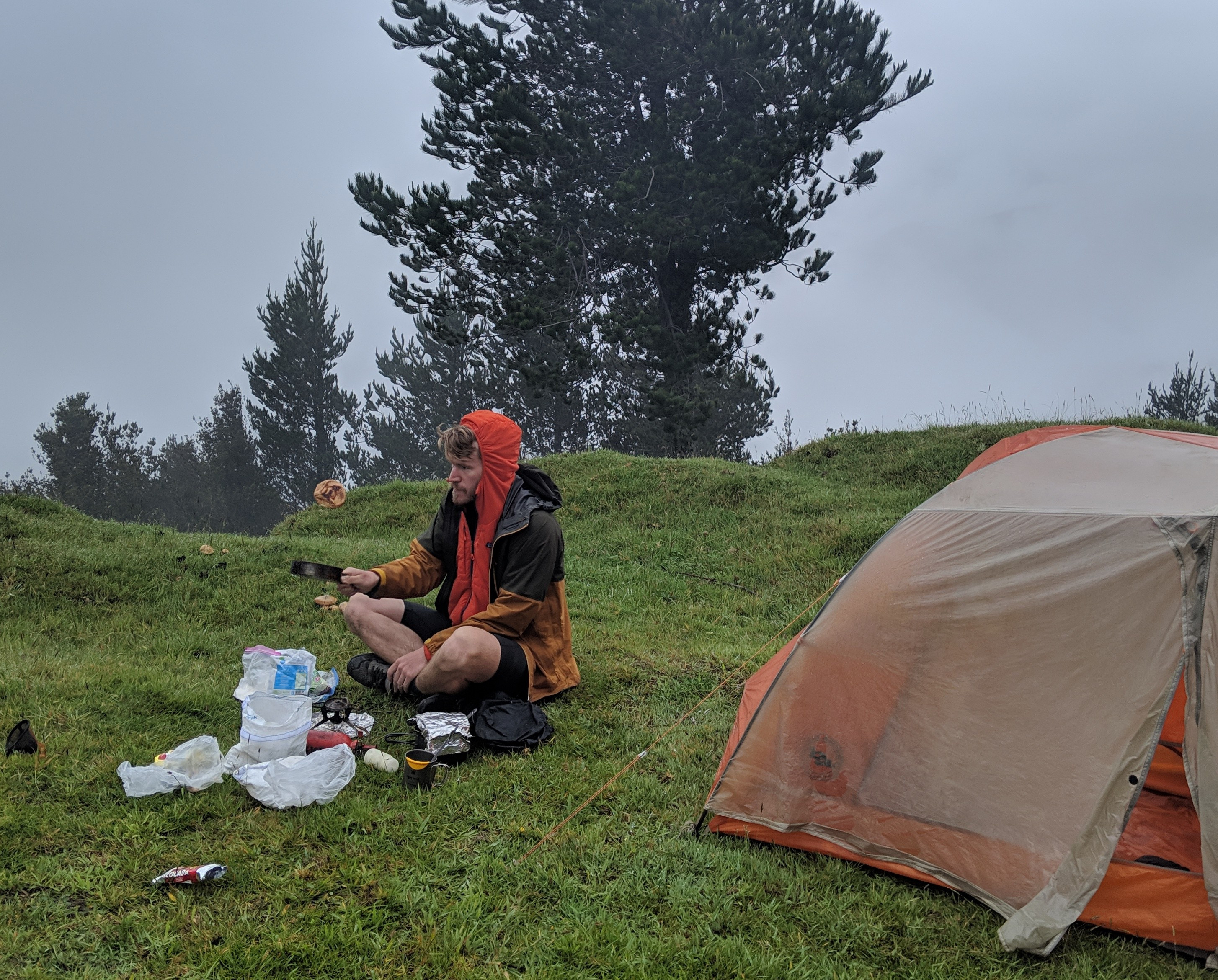
Finally, after eight months, I’m ready to pack.
It has taken days of being soaked to the bone through a softshell rain jacket, countless warranty replacements, endless frustration with crippled mobile websites and other such hard earned knowledge to finally have a set of gear that I feel good about. While this post won’t be the most interesting for everyone following along from home, I hope that anyone planning a similar trip can benefit from the strong opinions I’ve developed about every last thing I’ve carried across more than seventy lines of latitude.
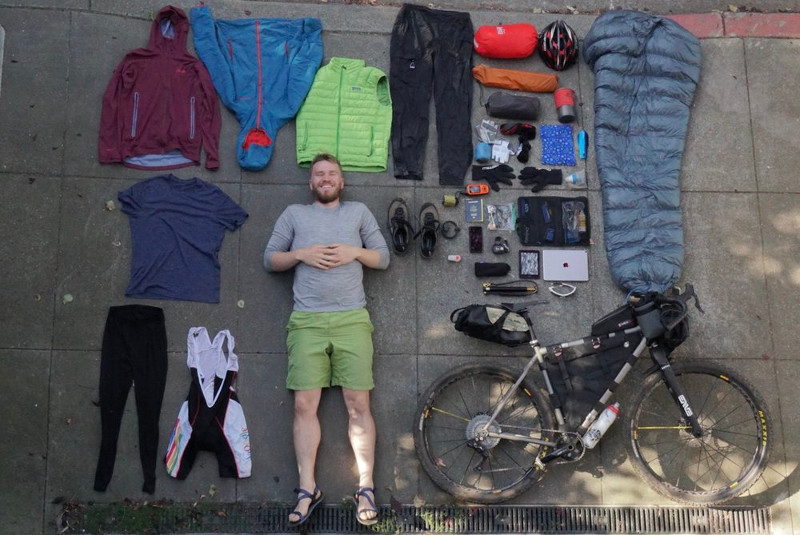
While I’ve swapped out a few items that didn’t hold up and dropped a few more that proved unnecessary, I’m still carrying largely the same gear with which I set out from Alaska. While everyone’s initial reaction is amazement at how little we’re carrying, we’ve found our setup to provide us with everything we need to be comfortable on the road. By carrying roughly half the weight in gear of many cycle tourists in bikepacking bags that are much more aerodynamic than the traditional rack and panniers, we’re able to cover more miles every day and tackle more challenging trails.
This is the first of a three part gear review, covering clothing and camping gear. Follow-up posts will discuss bike gear and digital paraphernalia.
I’ve marked each item as either being a strong recommendation, neutral, or something to avoid. Also, I’ve marked items that I started with but dropped and have picked up along the way.
If you have any questions about what we’re carrying (or aren’t) please leave a comment at the bottom of the post – I hope it will be helpful for you or anyone else packing for an adventure!
Clothing
Shirt

I’ve worn a lightweight, Merino wool Icebreaker t-shirt every day for the past eight months. A high quality Merino wool shirt is a must, for its durability, odor resistance (just ask Caitlin!), warmth when wet, comfort and sun protection. It doesn’t dry as fast as many synthetics, but it’s actually very nice to soak it through to cool off while riding under the blazing desert sun. I began the trip with a second, similar Icebreaker long sleeve shirt but quickly learned that a second t-shirt wasn’t a luxury that was important to me. Icebreaker agreed to replace my shirt, as so many pulls developed in the fabric after five months of hard use. Both the original and replacement shirts faded significantly from dark navy blue to a pale ghostly shade on the back. Despite the varied abuse I’ve subjected my shirt to, it still looks smart enough off the bike that I’m often told (complemented?) that I don’t have the long distance bike tourist “look.” An important part of avoiding the look of someone living off their bicycle is to regularly wash your clothes. For us, this almost exclusively means hand washing with soap in the sink. Without a change of clothes and lots of slow-drying wool, this means that I’ll often wear a wet shirt after washing if it’s hot, or just go shirtless under my jacket when it’s cold.
Underwear
Similarly, my Icebreaker boxers translate all the benefits of a Merino wool shirt to more delicate regions. These are super comfortable and sturdy, and they’re wonderful to slip on at night as relief from long days in a chamois. They resist odor well enough to survive between infrequent bathroom sink washings without causing excessive offense. I’m carrying a pair of Patagonia long underwear that I wear on some nights and particularly cold days.
Bike shorts
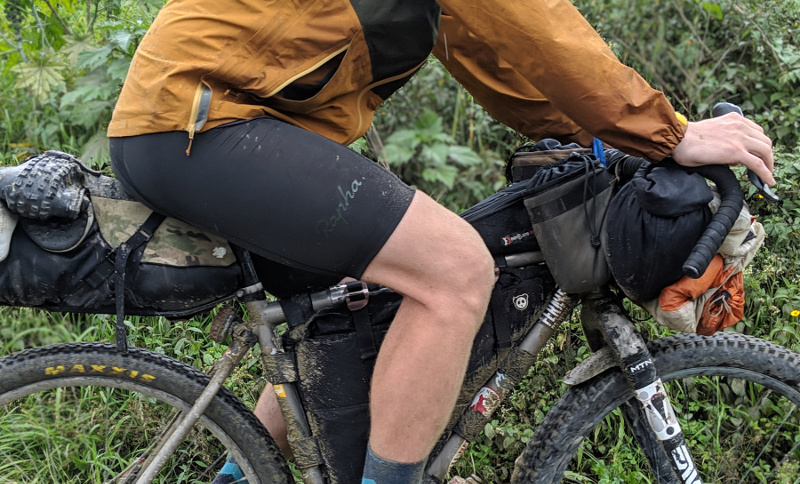
A pair of bib shorts with a high quality chamois is one of the most important investments for a long bike tour, as it will minimize chafing and other unpleasantness. The pair of bib shorts I started the trip with finally gave out in Mexico, and I upgraded to a pair of Rapha classic bib shorts They are very well constructed, fit me well and have a wonderfully thick, durable and comfortable chamois. They have shown very little signs of wear over three months of constant use. They have an easy to reach rear pocket that’s perfect for stashing a phone or wallet when I hop off my bike during the day.
Shorts
While I’m wearing my bib shorts almost always when I’m on my bike, it’s nice to occasionally change into something that doesn’t immediately identify you as being more comfortable planted on a small, hard piece of plastic than anywhere else. Caitlin gave me for my birthday a pair of Kitsbow Masterlink shorts which are designed as performance mountain bike shorts but still look sharp off the bike. Like everything from Kitsbow, they are very well made. Its integrated belt keeps them in place whether I’m swimming under a waterfall, ripping down rocky singletrack, or running around in a pick-up soccer game. All of the pockets are zippered, making pickpockets less of a concern in bustling Latin American cities. These replaced a pair of lighter weight Prana Mojo shorts which wore though in multiple places and generally looked out of place in a nice restaurant.
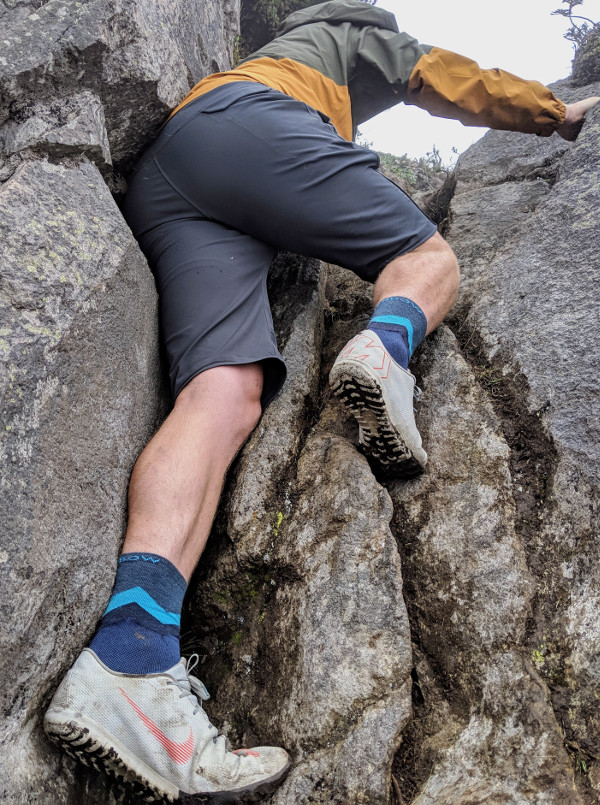
Socks
The right pair of socks for the conditions can make the difference between your feet being comfortable and either a soupy, boiling mess on a hot day or a numb block of ice after a day of riding at 12,000 ft in a mix of rain and hail. Once again, Merino wool is the way to go. From their own extensive adventures, Caitlin’s parents Tim and Loreen really know their socks, and gave me for Christmas this year a pair of Kitsbow wool socks and comfortable Showers Pass waterproof socks. The Kitsbow socks are my everyday pair, are breathable and comfortable for anything from chilly, dry days in the 40’s to days when the temperature climbs into the low 90’s. I put on the waterproof socks for protracted rainstorms or when the temperature turns truly frigid. These have kept my feet comfortable through even the nastiest weather we’ve encountered. At this point, we’re past the equator and have left the hottest weather behind, but when the temperature would regularly top 100 degrees I was carrying a lightweight pair of Sock Guy wool socks and a pair of synthetic socks. Synthetic socks were all I could stand to wear in really hot weather, though the stench of them after a few hot days was literally breathtaking.
Jackets
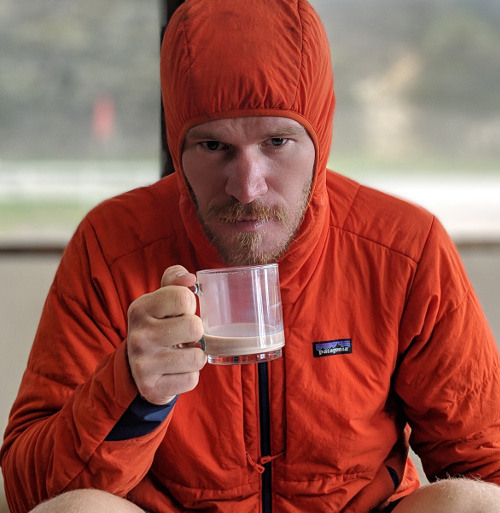
The Patagonia Nanoair hoody is my all-time favorite insulated jacket. It’s highly breathable, stretchy, and comfortable. In cool weather it blocks the wind enough to keep me comfortable on a fast descent, and I can leave it on for the next climb without sweating it through. Its DWR finish holds up well to brief rain showers. It also feels great to wear to sleep. The Nanoair isn’t the most packable jacket out there, and many other jackets have a better weight to warmth ratio, but it is very versatile and I’ve been comfortable even in even sub-freezing temperatures and heavy precipitation by layering the Nanoair with a hardshell jacket. I started the trip with the original model of the Nanoair hoody, but Patagonia replaced it with the 2018 version due to excessive pilling (and an ultimate death by being chewed up in my cassette). The newer version is warmer and less breathable than the original, so I would consider the Nanoair light for more moderate temperatures. I carried a Patagonia down vest through Alaska, but hardly ever needed the additional warmth and dropped it the first chance I got. If we ever expect to encounter extreme cold temperatures (<10 degrees F), I will pick up a Merino wool baselayer.
We were incredibly lucky with the weather through North America, with only a few days of rain in 5+ months. Ecuador, however has been a different story, and rarely a day goes by without a solid drenching. So, the rain jacket I started the trip with, a Rab Kinetic plus soft-shell, which breathes incredibly well and is very comfortable, has proven totally inadequate to heavy, extended storms. So, after getting soaked to the bone a few times, Abby and Julian brought down a Outdoor Research Foray hard-shell jacket to Quito. This jacket has held up well to heavy rains, and while the material isn’t nearly as breathable as the Rab, it does have full side zippers which essentially turn it into a poncho, so it ventilates as well as any hard-shell jacket.
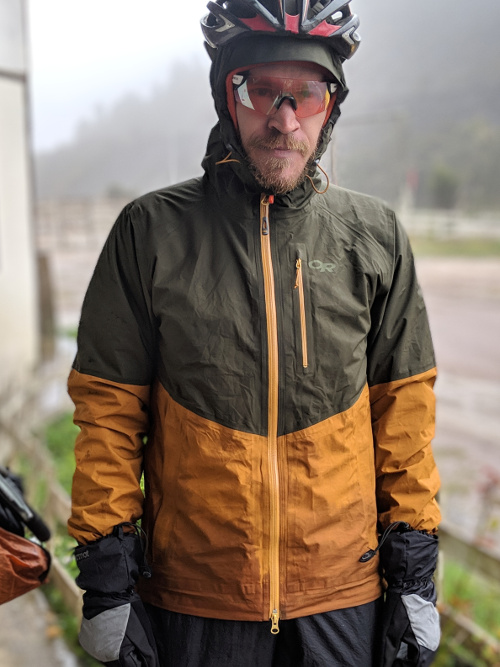
Rain pants
A light pair of rain pants are important for cold, rainy days. My Patagonia rain paints are very lightweight and packable. The ankle snaps make it easy to put them on and off over bike shoes, which you really appreciate during intermittent thunderstorms. These replaced a similar pair of Columbia pants which split apart at the seams.
Shoes
Bike tourists vary widely in their choices of footwear while riding. Some opt for sandals to beat the heat and dry out quickly, others prefer regular athletic shoes that work just as well off the bike, and some rely on bike specific shoes and cleats for optimal performance. Since we’re spending so many hours on the bike and covering so many miles every day, I prefer bike specific shoes that are most efficient for riding. My 5.10 Kestrel lace mountain bike shoes with SPD cleats are exceptionally stiff (for efficient pedaling), are easy to walk in off the bike, and strike a good compromise between breathability and warmth. I’ve been comfortable wearing them with a pair of light synthetic socks in 110 degree weather and in freezing rain with heavy waterproof socks. These replaced Shimano XM7 Gore-Tex bike shoes which I found to be terribly uncomfortable for most conditions. The Gore-Tex layer means that they don’t breathe at all, so once your feet get wet they’ll stay that way the rest of the day. No matter how waterproof your shoe material is, you’ll still get enough water coming in through the top to turn your shoe into a swimming pool. Now, your waterproof shoes just ensure that your swimming pool stays full to the brim. The Shimano shoes are also way more flexible than I prefer in a cycling shoe. They are also apparently styled with the assumption that you’ll never emerge from the backcountry.
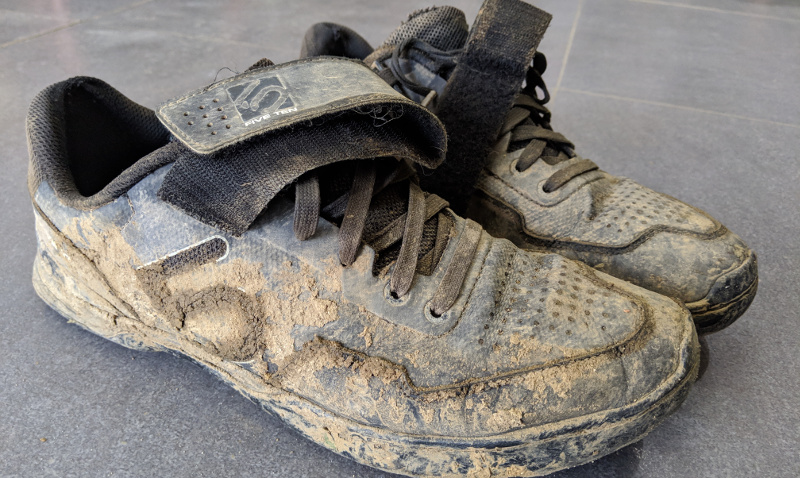
As any experienced hiker can attest, there are few better feelings than taking off your boots at the end of the day and slipping into a pair of comfortable camp shoes. The same is true for bikepacking. I started the trip with a pair of Xero sandals. These are very light and packable, but unfortunately the soles are so thin that every little pebble drives into your foot and even walking on cobblestone is uncomfortable. Furthermore, nothing screams dirty bike traveller like wearing sandals into a nice restaurant. So, in Guadalajara, Mexico, I swapped them out for Nike mercurial lightweight turf shoes which can pass for normal street wear but are still very light and compressible, and also make it possible for me to join in pick-up soccer games that we find along the way. They also work well enough even for aggressive day hikes.
Gloves
When the temperature drops and the sky opens up, my fingers are the first to suffer. I started the trip with Castelli neoprene gloves, which operate like Scuba gear and maintain warmth even when totally soaked. These keep my digits comfortable into the low 50s, and I like that they don’t get clammy from sweat the way a real waterproof glove does. However, I’ve found recently that they aren’t sufficient when it gets really cold, and so in Quito I pick up a pair of Marmot waterproof mitts. So far, they’ve proven to be totally waterproof and windproof, keeping me comfortable even when descending in pouring, near-freezing rain. They have minimal insulation and pack down very small, and could be layered with a lightweight liner for even colder temperatures. I find that I don’t have any issues shifting or braking with mittens, and appreciate the extra warmth, but some people might prefer the added dexterity that comes with gloves.
Accessories
A Buff is a great thing to have on hand, and has countless uses. On steaming hot days, it’s great to dunk in a stream and put around your neck to cool off and to block the sun, or to keep sweat out of your eyes. It’s a great face mask to block the wind on a cold descent. I even used it as a bandage to wrap a wound once when Caitlin wiped out.
I’ve got an unusually large head, and the Patagonia duckbill cap is one of the few hats I’ve found that fits me comfortably. It’s awesome on a hot day, as its mesh is very light but the fabric bill still absorbs sweat well. It is wonderful to wear by itself and fits well under a helmet. The bill is a little longer than a standard cycling cap, so provides excellent sun protection for your eyes on bright days.
Camping gear
Tent
I’ve used a Big Agnes Copper Spur UL2 tent for the last seven or eight years, and it has come with me on backpacking and bikepacking trips all over the world, without failing me once. As we were coming through Canada, the seam tape finally started to peel off, and one of the door zippers was acting up. Fortunately, we went right through Steamboat Springs, CO, where Big Agnes is headquartered, and they generously replaced my old tent with a new one. It is very spacious for an ultra-light tent, with generous headroom, and large porticos on either side to keep gear out of the rain. Most of the tent upper is mesh, so on hot nights, it’s great to sleep without the rain-fly and take advantage of cooling breezes. I do wish, however, that there were less nylon on the bottom of the tent sides, which blocks the wind. We’ve slept comfortably in heavy rain and wind without any issues. The Copper Spur is fairly light at around three pounds, and while there are lighter tents, especially the popular Cuben fiber single-wall options from companies like Z-packs and Hyperlite, I prefer the ease of use of a free-standing tent and the option to sleep without a rain-fly.
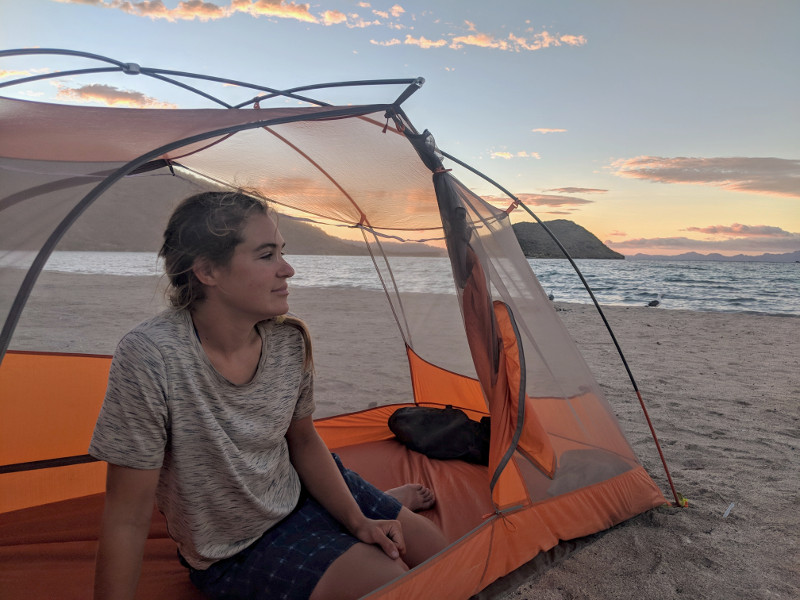
I have to admit that I used to think that the Big Agnes mtnGLO was silly. Basically, it’s a string of LED lights woven into a light piece of fabric, which you string around your tent for soft light at night. I have always just relied on my headlight and never saw the need to carry another piece of gear just to provide light. However, since the folks at Big Agnes headquarters in Steamboat Springs gave me one of these, I’ve found it to dramatically improve the experience of relaxing in the tent at the end of the day. The mtnGLO weighs less than an ounce, plugs into the USB power bank we’re already carrying, and proves nice, soft light that makes it all the nicer to relax with a book after a long day on the bike.
Cooking
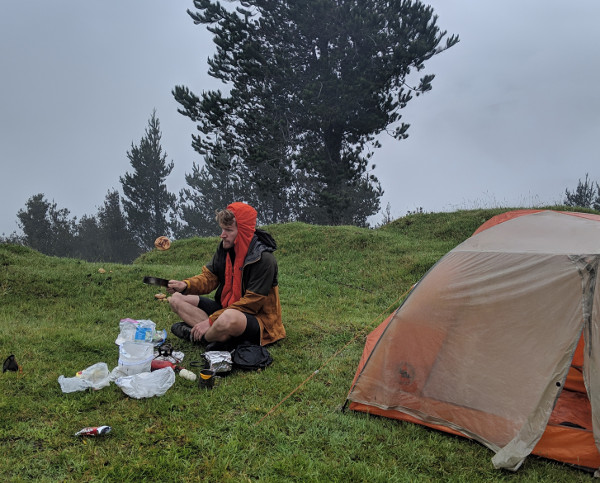
Caitlin and I love to cook, so inevitably our cooking equipment for this trip would be a disappointment. Nonetheless, it’s wonderful to tuck into a hot bowl of soup in your tent while a cold rain is pounding outside, so our camp stoves haven’t gone unappreciated. We began the trip with a MSR Windburner stove, which is very compact and hard to beat in ease of use and efficiency of boiling water. However, boiling water is about all it does, which seriously limits your culinary options. We were often in very remote places in North America, so it was critical to carry enough food for at least a few meals, which generally included rolled oats for breakfast, and some mixture of rice, pasta, dried vegetables, and seasoning for dinner.
The Windburner uses butane gas canisters which are difficult to find outside of the US, Canada, and Western Europe, so as we entered Mexico, we switched it out for a Whisperlite International stove. The Whisperlite International can burn white gas or unleaded gasoline, or kerosene with a different jet. (There is a non-international version of the stove which burns only white gas.) Make sure that you are using the right type of fuel for your stove, otherwise you will end up with a sooty mess. We made the mistake of using kerosene in Baja California without the kerosene jet and we’re still cleaning off the soot. Since then, we’ve been using unleaded gas, which you can fill up at any gas station and burns fairly cleanly. Industrial alcohol is also pretty easy to find in most big cities if you prefer an alcohol stove.
We haven’t found ourselves cooking very often in Latin America due to the universal availability of tasty, cheap food, but it’s certainly nice to have the option to make your own hot food. I carry a cheap lighter to ignite the stove, as well as matches in a waterproof case as insurance for a worst-case situation.
While the Whisperlite stove has an integrated 1L pot, we need to carry a REI titanium pot set for use with the Whisperlite. This 1L pot and pan set are very light, and makes it possible to attempt slightly more ambitious meals (frying pancakes, sauteing vegetables, etc). As a cooking instrument and utensil, I use a Sea to Summit titanium spoon.
Knife
A good knife comes in handy all the time, so I’m glad to have with me a Benchmade Bugout serrated knife. It’s simple, sharp, light and durable.
Sleeping
A good night’s rest is one of the most important parts to enjoying your time in the backcountry, and that’s even more true when you’re out for weeks on end. To stay warm and cozy on cold nights, I use a Katabatic Palisade 30 degree down sleeping bag, which weighs only about a pound and packs down to nearly a liter, yet still has impressive warmth. The non-standard system for attaching to your sleeping pad isn’t for everyone, but it works for me, and I appreciate the weight and volume savings from obviating the need for most of the back of the bag. On particularly cold nights, I’ll layer my down bag with a Sea to Summit silk Sleeping bag liner. A sleeping bag liner is also crucial for hot nights when you can’t bear even the thought of down, or for those seedy hotels whose TripAdvisor reviews don’t exactly exclaim the cleanliness of the bedding.
For a sleeping pad, the Thermarest Neoair Xtherm can’t be beat. This inflatable pad is super portable, warm, light, and comfortable. It’s also much less noisy than some other inflatable pads. The only downside, other than price, is that it’s fairly delicate, so it’s important to avoid placing it on sharp sticks, thorns or other things that might puncture it. I always inflate it using the included inflater, as I found with a previous pad (replaced because some of the baffles had given out) that breathing too much warm, humid air into the pad every night was the perfect recipe for all sorts of undesirable colonies to develop inside.
Finally, I never camp without my Sea to Summit inflatable pillow. It packs down very small, and completely eliminates the stiff neck I always used to wake up with when I would just ball up extra clothes in a sad imitation of a pillow.
Water
Requirements for carrying water vary dramatically depending on the climate and frequency of rivers and streams. When we’re riding through wet country with abundant clean mountain streams, I’ll generally not carry more than two liters of water at a time, and simply filter water along the way, whenever I run out. On the other hand, I’ve had to carry as much as twelve liters, on a 120 mile stretch of the Baja Divide with no supplies, which can be covered in two hot, long days.
I drink most of my water from a Platypus Hoser 3L hydration system that I keep in my frame bag and run the hose up between my feed bags, so that it is easy to access while riding. The design of the Hoser is nice as the bag unscrews entirely from the hose, so that you can remove the bag from your bike to fill, while leaving the hose in place. The bag, unfortunately, is pretty thin, and it did once spring a leak due to it being jammed in my frame bag with something pointy, requiring a replacement.
When I need more than three liters at a time, I fill up another Hydrapak 3L reservoir. This is super sturdy construction, has straps for attaching it on the outside of your bike, and packs down to almost nothing when not in use.
Finally, I carry a 700 ml water bottle for extra water carrying capacity as well as the convenience of having a bottle that you can spray to clean off your bike or deter aggressive dogs (or to return fire when ambushed by kids with water balloons; apparently this is a popular pastime in rural Ecuadorian villages).
For filtration, I use a Katydyn BeFree 1L water filter, which is very compact, easy to use, and has an impressive flow rate. The bag is fairly sturdy, though I did have to replace it once when a seam started to leak. My favorite aspect of this type of filter, though, is the ability to stop for ten seconds at a creek on the side of the trail, fill up the filter, and drink directly from it as you ride. When creeks are everywhere, this is the only water I need to carry. Caitlin is using a Sawyer Squeeze, and we both feel that the BeFree is more convenient as an integrated system and that the bag is much more robust. Note that this style of filter (both the BeFree and Sawyer Squeeze) doesn’t remove viruses, so you’ll need to use an extra level of purification in areas where that is a concern.
Light
Though we try to avoid riding after sunset as much as we can, as the combination of averse lighting conditions and drunk and/or tired drivers definitely increases the risk to cyclists, it will inevitably happen that you’re a few miles from your destination as the sun dips below the horizon, so it’s critical to be prepared. I’m only carrying a single Black Diamond reVolt headlamp, rather than a bike mounted light, which I use both for riding at night as well as off the bike. The high setting provides just enough light to comfortably descend a rocky trail at night, and the USB charging port makes it easy to keep it at full power. It’s not nearly as powerful as many bike lights, but it should be perfectly sufficient if you’re not planning to do a lot of night riding. One downside to riding with a light on your head is that every bug within a quarter mile will do its best to embed itself in your eyes, , so you need to to wear a pair of glasses with good coverage.
I’ve also got a couple USB rechargeable rear lights, crucial for making sure you’re visible to cars at night.
Miscellaneous
Sometimes when you’re camping and don’t feel like immediately going to bed, it’s delightful to build a fire, whether it’s for roasting a piece of meat, toasting smore’s, or simply to enjoy the warmth and dance of the flames. I find that carrying a small bag of dry cotton balls makes starting a fire much easier. Perhaps a more proficient fire-maker wouldn’t need this crutch, but with two or three cotton balls pulled apart to maximize their burning time, I can reliably get a fire started, even without ideal kindling.
I have often heard the joke that Alaska’s state bird is the mosquito, but always assumed that it exaggerated their severity. Since riding through the North Slope of the Brooks Range, I can confirm that this is not the case, and I owe Caitlin’s mom, Loreen, endless appreciation for her insistence that we bring Sea to Summit mosquito head nets. I would immediately reach for my head net every time I came to a stop in Alaska, in the roughly five seconds before being covered head to toe with the ruthless bloodsuckers. I even bought a replacement head net after donating mine to a cyclist heading north out of Fairbanks who had naively decided he could survive without it. It might be an indication of a latent Alaskan trauma that I still derive great comfort from carrying a head net, despite not needing to take it out of my bag for many thousands of miles. The tiny size is well worth the peace of mind.
I don’t use my TheTentLab Deuce #2 trowel often, but sometimes you just need a hole in the ground this instant, and in those cases it pays to have the proper tool. To be honest, I could probably get by without it and just use whatever is on hand for excavation, but I worry that that would only invite disaster.
And, don’t forget your toothbrush (sawed in half, obviously)!

